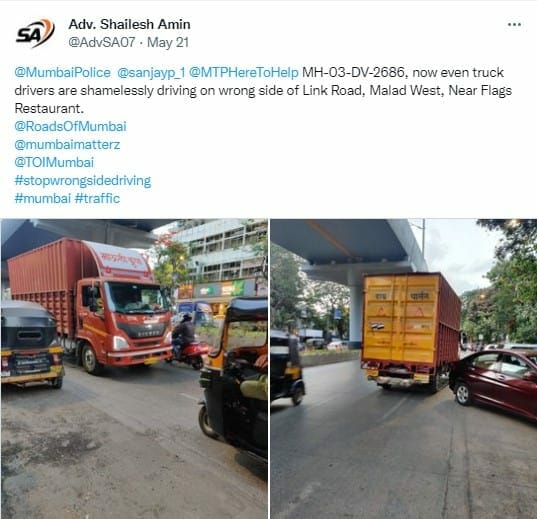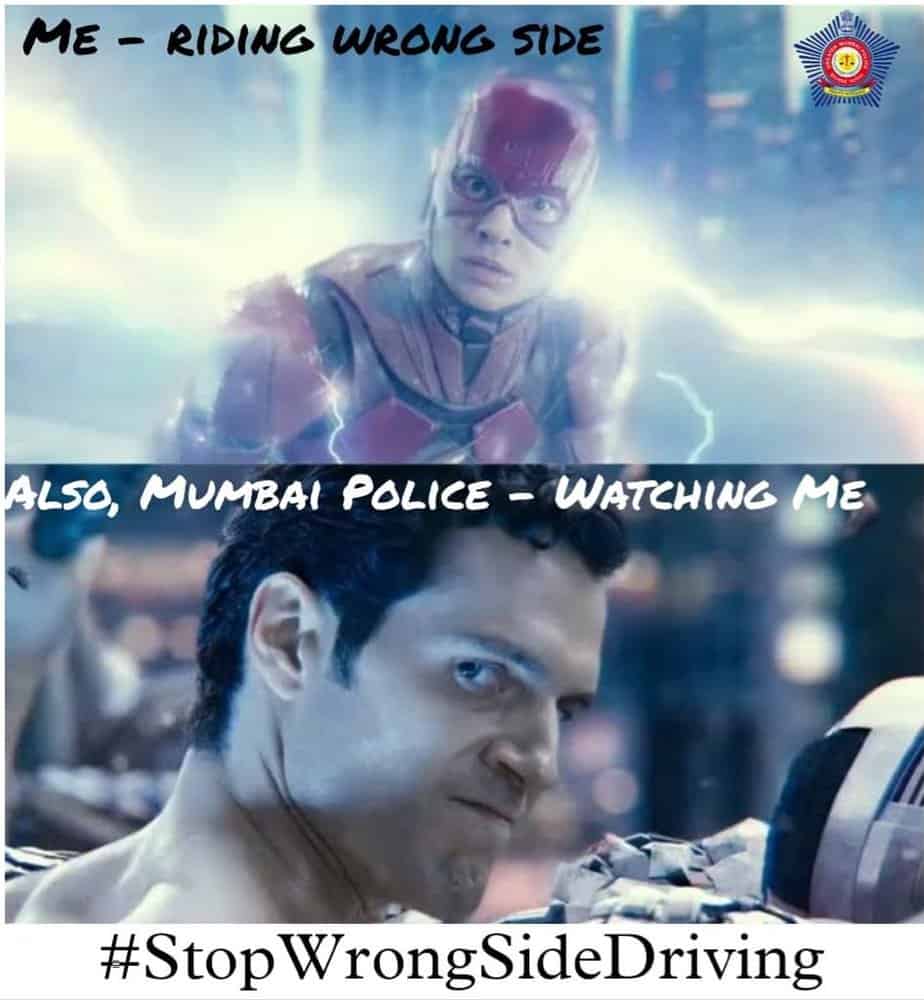On April 24th, the popular account @RoadsOfMumbai held a poll on Twitter asking a simple question, ‘Will wrong-side driving ever end in Mumbai?’ The response was overwhelmingly negative; over 80% of respondents believed they would just have to live with it.
The poll came nearly two months after the Mumbai police started a crackdown on traffic violations and road obstructions. They were particularly targeting offences of driving on the wrong side of the road and parking of defunct vehicles, ‘khataras,’ on the road. From March 6th to May 15th, the police claimed to have registered 12,390 wrong-side driving cases and removed 13,430 khataras.
However, the campaign against errant drivers – mainly bike and scooter drivers – driving in the opposite direction of the road has been on for a long time on social media. “Our account has been highlighting the menace of wrong-side driving from back in 2019, and even before,” said the activist behind @RoadsOfMumbai, who prefers to remain unnamed. “The practice was not very common in Mumbai until a few years back. We, Mumbaikars, were very proud of this discipline.”
With the ever increasing number of four and two-wheelers on the road, the practice of wrong-side driving has become frequent. And as social media, especially Twitter, has become a space to call attention to offences and complaints across the board, wrong side driving has not gone unnoticed. Tweets with the hashtag #WrongSideDriving tagging the police (@MumbaiPolice) and traffic police (@MTPHereToHelp) have become a daily occurrence.
With regards to his poll, @RoadsOfMumbai stands with the majority. “Even after months of the campaign by the traffic police, there is no visible decline in wrong-side driving on the ground. The police need to accelerate the drive and go aggressive against the offenders, until then, this soft approach will not show any results,” he said.

What leads people to drive on the wrong side of the roads?
“It is mainly in the last two years, due to the increase of two-wheelers, that wrong-side driving has become routine,” says AV Shenoy, a transport analyst from the Mumbai Mobility Forum. “The moment the two-wheeler riders see a traffic jam ahead, they immediately switch to the other side of the road. Four wheelers don’t do it as often.”
Another common reason for disregarding the road direction is to avoid long detours. Physical road dividers, which are barriers to switching sides, end up becoming the reason people drive on the wrong side till they can switch to the right side at a junction. “The constant diversions and road closures due to large (and small) construction work has increased travel time. Motorcycles are obviously quite agile compared to larger vehicles, and we’ve observed that very often, to avoid longer detours or wait times, a lot of them choose instead to drive on the wrong side,” says Dhawal Ashar, the Integrated Transport manager at WRI India.
Citizens and activists also believe that lacklustre enforcement in the past has increased impunity among riders and drivers to continue to drive in the opposite direction, and take offence at those who question them. “When confronted, they become violent and abusive in most cases,” says @RoadsOfMumbai. “The offenders consider it their birthright to drive on the wrong side. They counter that when the traffic police don’t have a problem with them, why should a citizen stop them?” He adds that the practice has gradually extended to other vehicles, like rickshaws, BMC garbage dumpers, BEST buses and radio cabs, too.
“People don’t care about others and give priority to their convenience alone,” says Jitu, who has complained about the offence on Twitter often. “If the police don’t catch them and levy a fine regularly, the offenders are okay with paying the fine once in a month or year in return for the convenience. Bad traffic is also a reason, but then that becomes a circle because these violations also cause traffic congestion.”
Read more: Mumbai, this is how you can tackle traffic jams
The gaps in enforcement
“All over the world traffic is regulated by infrastructure (signals, roundabouts etc), and the police are the enforcers,” says Dhawal. But in Mumbai, it is common to see the traffic police regulating traffic at peak times. “That automatically constrains enforcement capacity,” he says.
CCTV cameras also have not plugged this gap. Most of them are under manual observation, with one personnel noting down vehicle plate number and the other generates the challan. Cameras that are capable of automatic number plate recognition (ANPR) are very rare and expensive.
And while some citizens have added to the surveillance by reporting wrong-side driving offences on Twitter and the traffic police’s app MumTrafficapp, it is difficult to measure the difference made by them. The Mumbai police usually responds to complaint tweets with “We have informed traffic branch,” but with no confirmation that the driver has been charged with a challan. The MumTrafficapp itself is the target of complaints, and many users report being unable to capture and upload an image of the crime in time.
“But that’s not how the system is supposed to work,” says Shenoy. “A citizen may post a picture out of his or her initiative, but that cannot be the mechanism through which the law is enforced.”
Shenoy adds that the traffic police has focused much more on helmets and other driving offences, while driving on the wrong side also has the potential to be dangerous for others on the road. It claimed the lives of 12 people and injured 178 between January 2019 and July 2019, as revealed in an RTI response to @RoadsofMumbai and Mumbai North Central District Forum (MNCDF).
“The driver can knock down a pedestrian, or a car may steer to avoid them and knock someone down,” he says.
And while the RTI also revealed that 86,400 drivers were fined with e-challans for the violation, Shenoy estimates 80% of e-challans are never paid. “People don’t take e-challans seriously, as most of them don’t bother to pay the fines or don’t know they have been challaned, as their mobile numbers are not linked to their vehicle details,” says @RoadsOfMumbai.
The problem comes down to a lack of will, according to @RoadsOfMumbai. “Nowadays, people think ten times before drinking and driving or driving without seatbelts. Why? Because the traffic police have continued to go hard against these offences, unlike wrong-side driving. If they want, they can surely instil fear amongst the offenders,” he replies.

The solution
The start of the police’s campaign against wrong-side driving in March accompanied a change in the penalty for the offence. Instead of the Rs 1,000 challan, offenders are now charged with an FIR for rash and negligent driving, sending them to court.
However, the activist behind @RoadOfMumbai does not think it is enough of a deterrent. He recommends a concerted 6-12 month campaign using social media posts, PSAs on radio channels, TV, newspapers, etc, along with an aggressive crackdown on offenders. “The police should confiscate their vehicles, cancel their driving licences and slap heavy monetary fines on them, minimum Rs 10,000.
“But, this issue cannot be resolved by enforcement alone,” says Dhawal. “Mumbai’s infrastructure needs a careful, coordinated and consultative approach, driven by a larger focus on moving people and not just vehicles. But even in the short term, a combination of localized infrastructure, enforcement and engagement actions can hopefully resolve this issue to a large extent.”
To illustrate, areas with wrong-side driving as a widespread issue can indicate an unmet demand and benefit from collective solutions by residents. Localised enforcment can also play a role here, as Jitu suggests the police oncentrate on spots notorious for the practice for a few days in succession.
Infrastructural changes can mean restricting roads to match their needs. “We’re also noticing a lot of residual space on the road, where vehicles move in a few lanes and the remaining area is being used for parking, hawking, pedestrians walking, etc,” says Dhawal.
Other ways of discipline can increase the effectiveness of existing enforcement regulations. “People need to understand the severity of the crime,” says Shenoy. “They should be made to undergo 1-day of training at the police institute, or be given some social work.” Jitu recommends that the offenders face a time penalty of 10-15 minutes, in addition to the fine.
Activists say a well-rounded approach will go a step beyond enforcement, beginning with increased awareness about the danger involved in wrong-side driving and engagement with residents and drivers all alike.
The solution is petrollinģ by our RTO Officers during the day hours. This aspect will reduce or eliminate this problem.
The political system changes Commissioner post every 2 3 years for the self gratification of the Minister. In NYC the Commissioner post is a long tern project where public safety policies are established and set for the future. We need one Commissioner lead for longer tine.
Parents need to teach there kids to drive properly. We as an Indian belive in our religion first then being a good responsible citizen! Let’s change this attitude and become a great citizens.
Road design needs to change also. Muncipalties need to be responsible to get rid of the businesses on the fort path to have smooth trafic. Here, the running party needs to support the system rather than the venders who illegally support the wrong side.